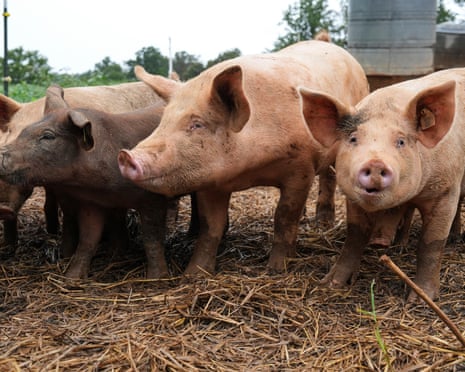Science
Surgeons Achieve Milestone with First Pig Lung Transplant

Surgeons have successfully transplanted a genetically modified pig lung into a brain-dead human recipient, marking a significant advancement in the field of xenotransplantation. The procedure, which took place in China, demonstrated that the transplanted lung functioned effectively for a period of nine days, offering a glimpse into potential solutions for the ongoing organ shortage crisis. According to the World Health Organization, only about 10% of the global demand for organ transplants is currently being met.
This groundbreaking research, published in the journal Nature Medicine, involved the left lung from a Chinese Bama Xiang pig, modified with six genetic changes to decrease the likelihood of organ rejection. The study’s authors reported that the lung remained viable and functional for a total of 216 hours and did not provoke hyperacute rejection, which is a rapid immune response often seen in transplant cases.
Despite this success, experts caution that there is still a considerable way to go before pig lungs can be deemed safe for use in living patients. Dr. Justin Chan, a lung transplant surgeon at the NYU Langone Transplant Institute, characterized the study as “exciting and promising work,” but emphasized that it only involved one patient and should be viewed as a “qualified success.” He noted, “These lungs are not able to independently sustain a patient.”
In agreement, Professor Andrew Fisher from Newcastle University stated that while this research enhances understanding in the field, it represents an incremental advancement rather than a revolutionary breakthrough. He pointed out the unique challenges posed by lung transplantation, particularly the need for lungs to combat environmental threats, such as pollution and infections. “The immune system in the lung is very sensitive and very active, which means that organ transplantation poses extra challenges,” Fisher explained.
The process of xenotransplantation has gained momentum in recent years, with various organs, including hearts, kidneys, and livers, successfully transplanted from pigs to humans. Typically, these organs are genetically modified by removing specific pig genes and inserting human genes to improve compatibility. Initial studies often involve brain-dead human recipients, as this allows researchers to assess organ viability before considering living patients.
While there have been a few instances of living recipients undergoing such surgeries, many have faced severe complications, leading to death within weeks or months. In contrast, some patients who received pig kidneys have survived for several months with functioning organs, raising hopes for the future of xenotransplantation.
The recent lung transplant study highlighted several issues. Although the lung performed well initially, it showed signs of fluid accumulation and damage shortly after transplantation, likely due to inflammation linked to the procedure. Despite administering strong immunosuppressive medications, the lung experienced progressive antibody attacks, leading to significant damage over time. Professor Peter Friend from the University of Oxford noted that the brain-dead state of the recipient likely contributed to the complications observed.
The researchers acknowledged that their approach requires refinement. They stated, “Continued efforts are needed to optimize immunosuppressive regimens, refine genetic modifications, enhance lung preservation strategies, and assess long-term graft function beyond the acute phase.”
In light of these developments, experts are exploring alternative methods to address the organ shortage, including the possibility of remodelling donor organs with stem cells. There is also ongoing research into the feasibility of growing humanized organs inside pigs or sheep. Fisher pointed out that while xenotransplantation offers promise for lung transplants, treating human donor lungs that are currently deemed unsuitable for transplantation could yield immediate benefits. “If we get that right, that’s something that can be implemented within months, and certainly in years could be making very big differences,” he concluded.
-

 World5 days ago
World5 days agoCoronation Street’s Shocking Murder Twist Reveals Family Secrets
-

 Entertainment4 months ago
Entertainment4 months agoKate Garraway Sells £2 Million Home Amid Financial Struggles
-

 Entertainment3 months ago
Entertainment3 months agoAnn Ming Reflects on ITV’s ‘I Fought the Law’ Drama
-

 Entertainment3 days ago
Entertainment3 days agoAndrew Pierce Confirms Departure from ITV’s Good Morning Britain
-

 Health3 months ago
Health3 months agoKatie Price Faces New Health Concerns After Cancer Symptoms Resurface
-

 Entertainment4 weeks ago
Entertainment4 weeks agoCoronation Street Fans React as Todd Faces Heartbreaking Choice
-

 World4 weeks ago
World4 weeks agoBailey Announces Heartbreaking Split from Rebecca After Reunion
-

 Entertainment1 week ago
Entertainment1 week agoTwo Stars Evicted from I’m A Celebrity Just Days Before Finale
-

 World1 week ago
World1 week agoKevin Sinfield Exceeds Fundraising Goal Ahead of Final Marathons
-

 Entertainment3 months ago
Entertainment3 months agoCoronation Street’s Carl Webster Faces Trouble with New Affairs
-

 Entertainment3 months ago
Entertainment3 months agoWhere is Tinder Swindler Simon Leviev? Latest Updates Revealed
-

 Entertainment4 months ago
Entertainment4 months agoMarkiplier Addresses AI Controversy During Livestream Response





















